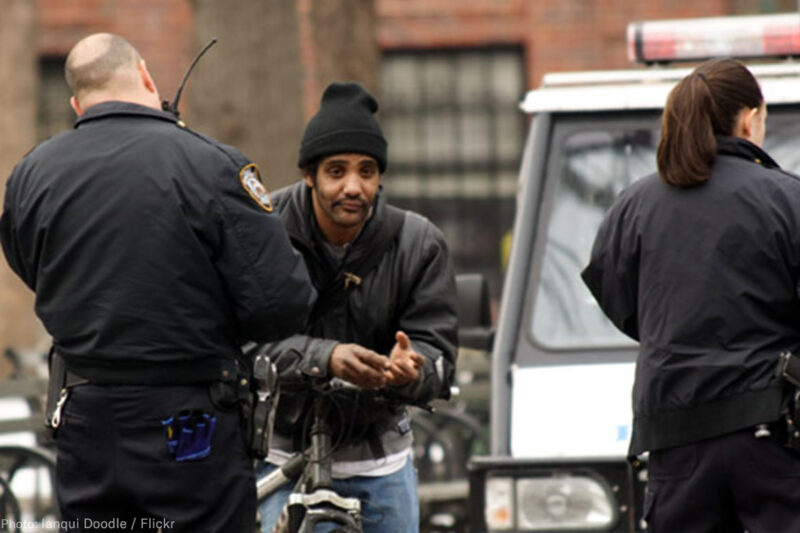
For years, Black and Latino residents of Milwaukee have protested the fact that they and their neighborhoods have been consistently and unfairly targeted for overzealous police stops. They were right to do so. New expert evidence unmasks the city’s stop-and-frisk program for what it is: a program that encourages routine stops of individuals that are without a sufficient legal basis and that are often based on the individual’s race or ethnicity.
With this new evidence, Milwaukee joins a host of cities nationwide whose stop-and-frisk practices — as reflected in their own data — run afoul of the law.
In 2017, the ACLU and the law firm of Covington & Burling filed Collins v. City of Milwaukee to challenge Milwaukee’s stop-and-frisk program. From 2007 to 2015, traffic and pedestrian stops in Milwaukee tripled from around 66,000 to a whopping 196,000. Expert reports released this week, relying on the city’s own data, show that a huge fraction of Milwaukee police stops are made without reasonable suspicion as required by law and disproportionately subject Black and Latino people to stigmatizing police encounters.
Margo L. Frasier, an expert with more than 40 years of law enforcement and criminal justice experience, including as the police monitor of Austin, Texas, and as the sheriff of Travis County, Texas, analyzed records of more than 716,000 pedestrian and traffic stops conducted between 2010 and 2017. She found that more than 350,000 — almost half of those records — fail to show that Milwaukee police had reasonable suspicion of criminal activity or a traffic or vehicle equipment violation prior to conducting such stops, as required by the Fourth Amendment to the U.S. Constitution.
Frasier also found that Milwaukee police are not required to document frisks — also known as “pat downs” — and therefore fail to collect information about the reasons police officers conduct them. She explains in her report that this prevents police supervisors and the Milwaukee Fire and Police Commission, which oversees the city’s police department, from ensuring that officers only frisk people when they have objective reasonable suspicion that a person is armed and dangerous, as the Fourth Amendment requires.
So if Milwaukee police stops aren’t based on objective reasonable suspicion, what are they based on? A report by David Abrams, an expert in law, economics, and public policy at the University of Pennsylvania Law School and The Wharton School, makes clear that Milwaukee police stop racial and ethnic minorities at higher rates than whites, and that factors other than race and ethnicity do not explain those differences.
Abrams found that Black and Latino people are more likely than white people to be subject to traffic stops across Milwaukee, including in areas in which the residential population is predominantly white. He discovered that even after controlling for non-racial factors — including crime rates — traffic and pedestrian stop rates in Milwaukee are both more than six times higher for Black people than for white people. He also found that Milwaukee’s rate of drug or weapon discovery from searches during traffic stops is extremely low — occurring in less than 1 percent of such stops — and that Black people are far more likely to be subjected to such searches. (That analysis also controlled for explanations other than race and ethnicity.) Abrams’ analysis shows that searches of Black and Latino drivers are more than 20 percent less likely to lead to the discovery of drugs than searches of white drivers — again, even after controlling for factors other than race and ethnicity.
These reports make clear what thousands of Black and Latino people — including the nine named plaintiffs in our case — already knew from being unlawfully stopped and frisked by police in the course of their everyday lives. Milwaukee police stops and frisks are about race and ethnicity.
And Milwaukee is not alone. Expert analysis of data produced by the police departments of New York, Boston, Chicago, and Philadelphia has also led to findings that race and ethnicity drive stops.
Recent data from New York City also shows that, contrary to warnings by critics, bringing stop and frisk practices in line with constitutional requirements does not result in a rise in crime. A federal court ruling striking down New York City’s stop-and-frisk program resulted in a 98 percent drop in police stops in 2016 from 2012 levels. Despite the dramatic decline in stops, there has been no corresponding increase in crime. In fact, in New York City, crime has decreased to lows not seen since the 1960s, inspiring some of those critics to change their minds.
The evidence from New York provides an important lesson for Milwaukee. Police and their oversight agencies should strive to ensure that stops and frisks are bias-free and grounded in reasonable suspicion. Race and ethnicity should never be their driving force.
Correction (5/8/18): The number of records analyzed by Margo L. Frasier was corrected to 716,000 from 350,000, and 350,000 was added as the number of those that failed to show that Milwaukee police had reasonable suspiciion for a stop.

